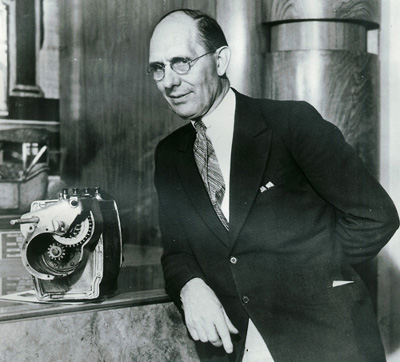slow, But if it breaks it comes down up goes elevator The so.
— Yale Record, 1900-1919
slow, But if it breaks it comes down up goes elevator The so.
— Yale Record, 1900-1919
New Year’s Day normally falls one week after Christmas: If Christmas falls on a Thursday, then New Year’s Day will fall on a Thursday as well. What is the most recent year in which Christmas and New Year’s Day fell on different days of the week?
Utica College mathematician Hossein Behforooz devised this “permutation-free” magic square in 2007:

Each row, column, and long diagonal totals 2775, and this remains true if the digits within all 25 cells are permuted in the same way — for example, if we exchange the first two digits of each number, changing 231 to 321, etc., the square retains its magic sum of 2775. Further:
231 + 659 + 973 + 344 + 568 = 2775
979 + 234 + 653 + 341 + 568 = 2775
231 + 343 + 568 + 654 + 979 = 2775
564 + 979 + 233 + 348 + 651 = 2775
231 + 654 + 563 + 978 + 349 = 2775
231 + 348 + 654 + 979 + 563 = 2775
And these combinations of cells maintain their magic totals when their contents are permuted in the same way.
(Hossein Behforooz, “Mirror Magic Squares From Latin Squares,” Mathematical Gazette, July 2007.)
Morse code palindromes, contributed by reader Dave Lawrence:
ANNEXING ·- -· -· · -··- ·· -· --·
BEEFIEST -··· · · ··-· ·· · ··· -
DEFOREST -·· · ··-· --- ·-· · ··· -
ESTHETES · ··· - ···· · - · ···
FINAGLED ··-· ·· -· ·- --· ·-·· · -··
HEARTIES ···· · ·- ·-· - ·· · ···
HECTARES ···· · -·-· - ·- ·-· · ···
INDEBTED ·· -· -·· · -··· - · -··
INTERNAL ·· -· - · ·-· -· ·- ·-··
INTUITED ·· -· - ··- ·· - · -··
RECENTER ·-· · -·-· · -· - · ·-·
SATIATES ··· ·- - ·· ·- - · ···
SEVENTHS ··· · ···- · -· - ···· ···
SHEEPISH ··· ···· · · ·--· ·· ··· ····
SOPRANOS ··· --- ·--· ·-· ·- -· --- ···
SUBHEADS ··· ··- -··· ···· · ·- -·· ···
WAVERING ·-- ·- ···- · ·-· ·· -· --·
WRECKING ·-- ·-· · -.-· -.- ·· -· --·
ANTICKING ·- -· - ·· -·-· -·- ·· -· --·
FOOTSTOOL ··-· --- --- - ··· - --- --- ·-··
FRESHENED ··-· ·-· · ··· ···· · -· · -··
INCIDENCE ·· -· -·-· ·· -·· · -· -·-· ·
SATURATES ··· ·- - ··- ·-· ·- - · ···
SIDELINES ··· ·· -·· · ·-·· ·· -· · ···
INITIALLED ·· -· ·· - ·· ·- ·-·· ·-·· · -··
INTERSTICE ·· -· - · ·-· ··· - ·· -·-· ·
RESEARCHER ·-· · ··· · ·- ·-· -·-· ···· · ·-·
WINTERTIME ·-- ·· -· - · ·-· - ·· -- ·
ANTIQUATING ·- -· - ·· --·- ··- ·- - ·· -· --·
INTERPRETED ·· -· - · ·-· ·--· ·-· · - · -··
PROTECTORATE ·--· ·-· --- - · -·-· - --- ·-· ·- - ·
INTRANSIGENCE ·· -· - ·-· ·- -· ··· ·· --· · -· -·-· ·
He notes that, perhaps fittingly, the word with the longest run of dots is OBSESSIVE, with 18: --- -··· ··· · ··· ··· ·· ···- ·
In 1945, the Arkansas legislature passed “An Act to Authorize and Permit Cities of First and Second Class and Incorporated Towns to Vacate Public Streets and Alleys in the Public Interest.” That seems boring enough. But § 8 read as follows:
“All laws and parts of laws, and particularly Act 311 of the Acts of 1941, are hereby repealed.”
With the stroke of a pen they had repealed every law in Arkansas. The state supreme court cleared its throat and ventured an improvement:
“No doubt the legislature meant to repeal all laws in conflict with that act, and, by error of the author or the typist, left out the usual words ‘in conflict herewith,’ which we will imply by necessary construction.”
(Act 17 of 1945 [repl. 1980; now Ark. Stat. § 14-301-301], cited in Antonin Scalia and Bryan Garner, Reading Law, 2012.)

I should have wished also to have referred to some of the serio-comic duels, such as that fought by the famous critic Sainte-Beuve against M. Dubois, of the Globe newspaper. When the adversaries arrived on the ground it was raining heavily. Sainte-Beuve had brought an umbrella and some sixteenth-century flint-lock pistols. When the signal to fire was about to be given, Sainte-Beuve still kept his umbrella open. The seconds protested, but Sainte-Beuve resisted, saying, ‘I am quite ready to be killed, but I do not wish to catch cold.’
— Theodore Child, “Duelling in Paris,” Harper’s New Monthly Magazine, March 1887
A prison warden greets 23 new prisoners with this challenge. They can meet now to plan a strategy, but then they’ll be placed in separate cells, with no means of communicating. Then the warden will take the prisoners one at a time to a room that contains two switches. Each switch has two positions, on and off, but they’re not connected to anything. The prisoners don’t know the initial positions of the switches. When a prisoner is led into the room, he must reverse the position of exactly one switch. Then he will be led back to his cell, and the switches will remain undisturbed until the warden brings the next prisoner. The warden chooses prisoners at his whim, and he may even choose one prisoner several times in a row, but at any time, each prisoner is guaranteed another visit to the switch room.
The warden continues doing this until a prisoner tells him, “We have all visited the switch room.” If this prisoner is right, then all the prisoner will be set free. But if he’s wrong then they’ll all remain prisoners for life.
What strategy can the prisoners use to ensure their freedom?

bedrabble
v. to make wet and dirty with rain and mud
Our change climatic
We think acrobatic
And sigh for a land that is better —
But the German will say,
In a very dry way,
That the weather with him is still Wetter.
— J.R. Joy, Yale Record, 1899
Founded in 1938 by Owen C. Cash and Rupert I. Hall, the Society for the Preservation and Encouragement of Barber Shop Quartet Singing in America boasts 23,000 members. Its more manageable name is the Barbershop Harmony Society.
The Guild of Former Pipe Organ Pumpers was created in 1927 by “Grand Diapason” Chet Shafer of Detroit, after meeting Sen. James Couzens (R-Mich.) and discovering that both had pumped organs in their youth. “He and Couzens commented on the fact that even in the smallest villages nowadays the organ is usually pumped by electricity, and therefore the profession of organ pumper is dying out.”
Founded in 1936 by public relations man Sidney Ascher, the Society for the Prevention of Disparaging Remarks About Brooklyn held weekly meetings over a local radio station. “Brooklyn has more men in the armed forces than any of 39 states,” Ascher insisted. “Ask anybody about their courage.”
When Crayola announced in 1990 that it would be retiring eight crayon colors, one dismayed fan sent them fax saying he’d be forming a group called RUMPS — the Raw Umber and Maize Preservation Society.
According to Guinness World Records, the labor union with the longest name was the International Association of Marble, Slate and Stone Polishers, Rubbers and Sawyers, Tile and Marble Setters’ Helpers and Marble Mosaic and Terrazzo Workers’ Helpers, an affiliate of the AFL-CIO.
Established as a joke in 1916 by lumber baron George W. Dulany, the Society for the Prevention of Calling Sleeping Car Porters George once boasted 33,000 members. At the time, the porters of U.S. sleeping cars were traditionally called George regardless of their given names.
And according to H. Allen Smith’s book People Named Smith, in 1942 University of Minnesota graduate student Glenn E. Smith founded the National Society to Discourage Use of the Name Smith for Purposes of Hypothetical Illustration. He was irritated that his professor’s lectures always centered on characters named James Smith. The society’s hundreds of members pledged themselves to confront offenders with a card that read “When you think of Smith, say John Doe!”

“An inventor is simply a fellow who doesn’t take his education too seriously.” — Charles F. Kettering